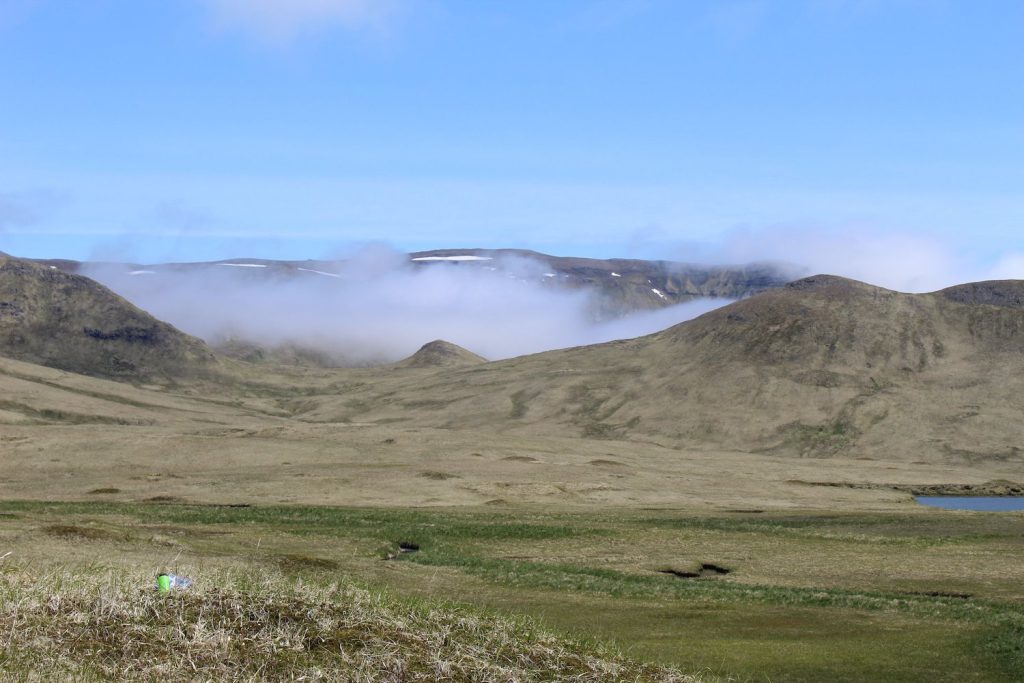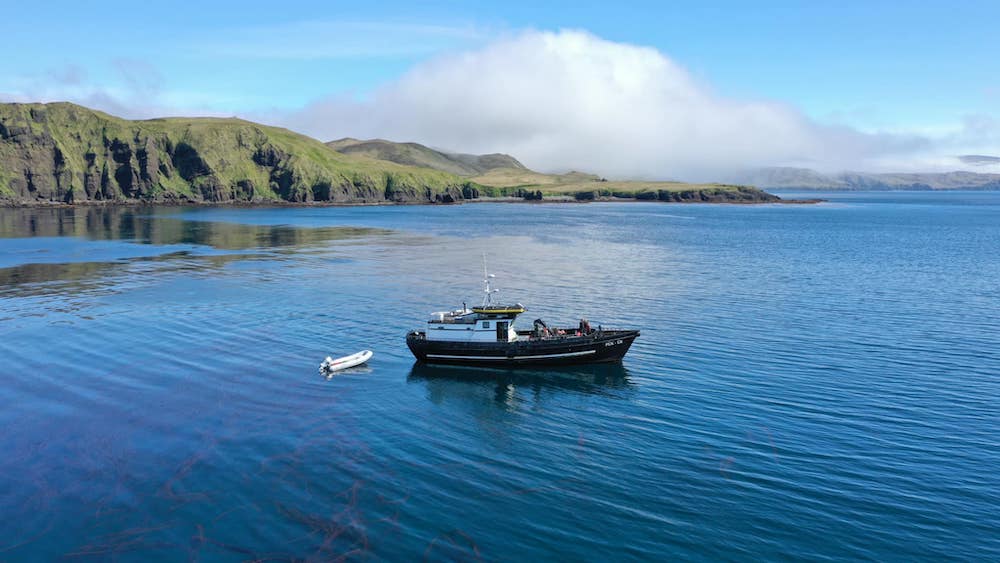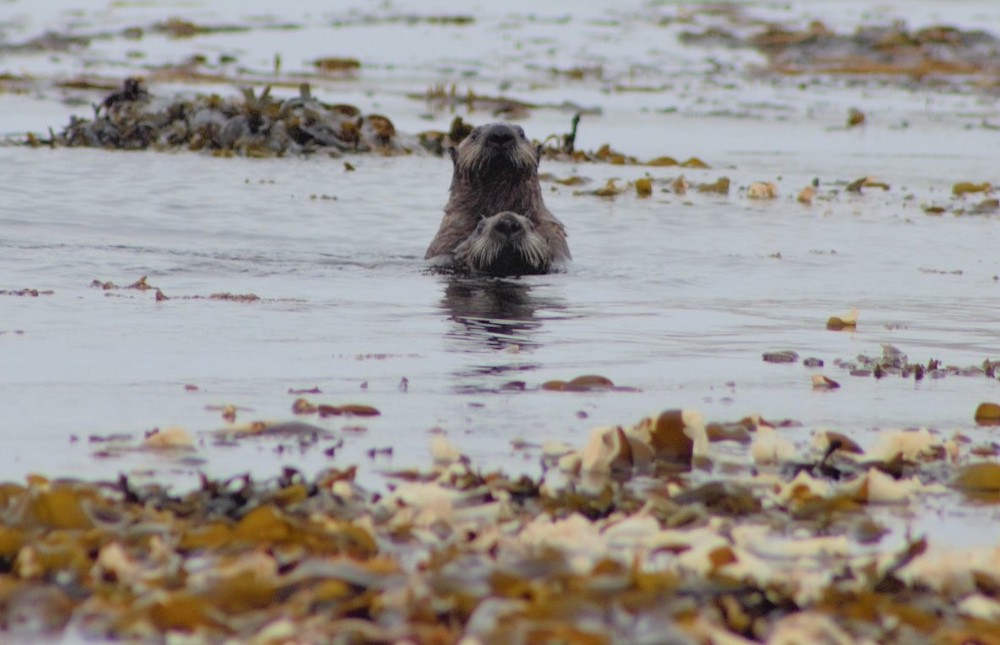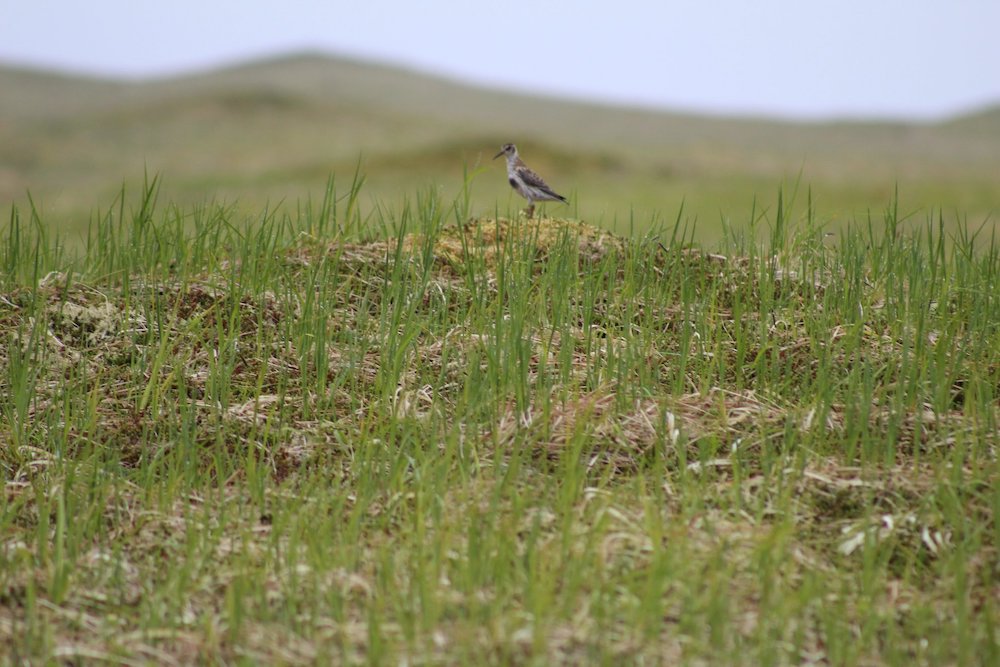Stop Calling the Aleutians Pristine

The Aleutian Islands, which stretch 1,100 miles across the Bering Sea from the Alaska Peninsula, are commonly described as “pristine” in books and documentaries. The remote islands, the majority of which are uninhabited, do indeed seem wild and mostly untouched by human hands. But they are not. As an archaeologist, I know that humans used these lands for thousands of years.
I have been studying archaeological assemblages from the Aleutians for six years but have had the privilege of making the expensive trip from Buffalo, New York, to the islands only once. In 2019, a several hours long flight from Anchorage brought us to Adak, the westernmost island in the Aleutians with an airport and one that has a population of around 300. From there, we loaded onto a boat for a 20-plus-hour ride to Kiska Island in the Rat Islands group.
Our first archaeological site on Kiska was in a protected bay. Like many ancient archaeological sites, its significance for past humans was only visible in very slight changes to the vegetation and topography. The rocky beach gradually rose up to meet rolling tundra completely devoid of trees. Occasionally, we would glimpse sea otters or sea lions in the bay, which would watch us just as curiously as we watched them.
Looking over that bay, it did feel as though we were in a place that was “pristine” or “untouched” by human hands. But using words like these is problematic. For one, it erases the history of Indigenous occupation, often to the detriment of living populations. We do not refer to places like the Mediterranean as pristine, even in spots with no modern habitation, because they were occupied by agriculturalists who more obviously shaped the landscape. Their history is more visible. But that does not mean that nonagricultural ancestors can be dismissed.
These terms also presume that humans are or should be the apex creature in an ecosystem. Rather, we should acknowledge that people are an integral part of nature, not “above” it. Too often, this dichotomy leads to the notion that “protecting” a landscape means excluding humans or human use. This is often to the detriment of Indigenous or local populations.
Even if these effects are unintentional, the word choice is still harmful.
The Aleutian Islands were occupied by the ancestral Unangax̂ for at least the past 9,000 years. In the 18th century, the Unangax̂ people (a population estimated to have once been as high as 15,000) were forcibly removed from the Aleutians by Russian colonists who came in search of sea otter and fur seal skins. Able-bodied Unangax̂ men were removed from their homes and forced to participate in the fur trade; others were killed fighting wars resisting the Russian invasion; yet more died from introduced diseases.
By the time the Aleutian Islands were sold to the United States in 1867, the majority of the Unangax̂ settlements had been obliterated, especially in the western Aleutian Islands. Today there are around 12,000 people that make up the descendent community, mostly living outside these islands.
Archaeological work in this region is still relatively sparse, and there are many areas that have not been fully investigated. Still, thousands of archaeological sites have been found throughout the archipelago. Chances are, if you are on an Aleutian Island, you are within several hundred yards of an Unangax̂-made feature.
There are no pyramids, no amphitheaters, and no clear-cuts in the Aleutians.
The ancestral Unangax̂ built long-term settlements made up of semi-subterranean dwellings (called ulax, or barabaras in Russian) that consisted of pits dug into the ground and covered by a frame of driftwood that was thatched with grass and insulated by earth. They also built hunting camps consisting of single, isolated barabaras and burial features such as mounds and caves, and they left behind large middens of shellfish and bone. Over time, the Unangax̂ built increasingly large and permanent settlements and sustained contact with one another throughout the archipelago.
In addition to altering the landscape and ecosystem by building and occupying settlements, the ancestral Unangax̂ also impacted Aleutian food webs. They were fisher-hunter-gatherers who ate fish, whales, fur seals, sea otters, birds and their eggs, and sea urchins.
According to the few surviving oral histories, ancestral Unangax̂ had a complex relationship with their landscape; they perceived all environmental factors as being imbued by spirits. Places, animals, and plants all were animated by different characteristics that influenced the way that they were employed in human culture. For example, predatory birds such as falcons and eagles were thought to be infused with power and their feathers were used as offerings to hunters.
From ethnographic accounts, we know that ancestral Unangax̂ passed down information about where and when migratory birds arrived so a hunting party could be launched upon the day of their arrival. They developed a systematic way to collect the largest possible catch, while also leaving enough to replenish the population for the next year’s hunting party.
Research into lasting Unangax̂ impacts on Aleutian bird populations has had contradictory results. Some studies have found that humans had little long-term impacts on birds, while others found that they lowered numbers of local nesting colonies.
My own research of archaeological remains on the Rat Islands suggests that humans continued to hunt specific birds even when their populations are thought to have dwindled due to climatic changes thousands to hundreds of years ago. People appeared to use birds that were important to their culture, whether those birds had large or small populations at the time.
Sea otters stayed away from areas where ancestral Unangax̂ lived, finding refuge in bays where the harsh landscape prevented human settlement. As a result, in many places in the Aleutians, the Unangax̂ hunted very few otters—on Amchitka Island, by contrast, where these refuges are closer to ancestral human settlements than on other islands, archaeologists find higher proportions of sea otter remains. Overall, it was the mere presence of humans that largely dictated sea otter distribution. Only after the Russians arrived were the abundant otters in the region hunted nearly to extinction.
The lack of sea otters near human settlements would have dramatically impacted the coastal environment. Sea otters eat urchins, and urchins munch on kelp. So, where there are otters, kelp forests thrive; where there are no otters, there are kelp barrens. The ancestral Aleutians would have looked like a mosaic of kelp barrens and kelp forests, with kelp barrens largely mirroring human coastal settlements. That was strikingly different from the extensive kelp forests present today.
Overall, the Aleutians have been relatively unscathed by thousands of years of human habitation. Most of the wildlife remained unchanged until the 18th century in part because animal population sizes were so large. Some—like birds and sea otters—shifted locally, but there’s no evidence of any extinctions due to Indigenous lifeways. And the remnants of ancestral human occupation are largely invisible to the untrained eye.
This, of course, is very different from the vast environmental alterations made by agricultural and industrial societies. There are no pyramids, no amphitheaters, and no clear-cuts in the Aleutians—and no major shifts to the animal populations or landscape across 9,000 years of forager lifestyles. That history has left little mark.
But living in a way that does not actively or drastically harm the environment in which you are situated does not mean that you do not have an impact on it. Nor does it mean the existence of ancestral Indigenous communities should be dismissed or forgotten by contemporary settlers. Most people have no idea that people ever lived in the Aleutians over the past many thousands of years; the Indigenous history has been largely forgotten by outsiders. The cultural loss and change that resulted from occupations by the Russians and during WWII has been devastating for the Unangax̂ people and other Indigenous populations in the region.
Using romanticized words like “pristine” makes social and cultural distinctions between Indigenous peoples and colonial industrialists that are harmful. Just because history is hard to see is no excuse for obliterating its memory.




































